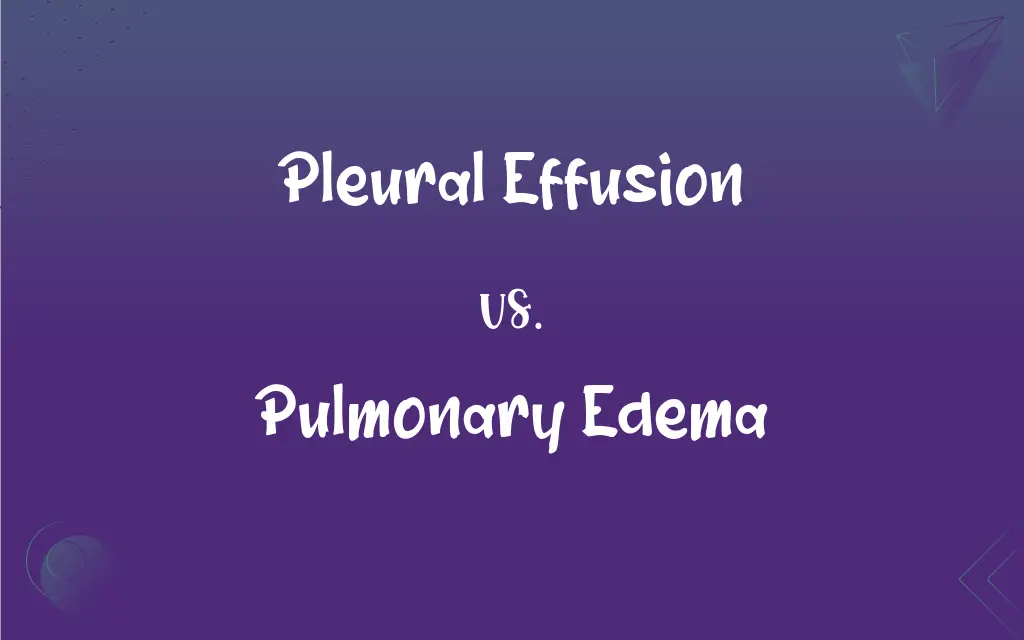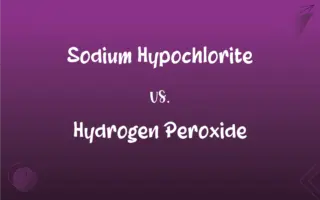Pleural Effusion vs. Pulmonary Edema: What's the Difference?
By Janet White & Harlon Moss || Published on November 12, 2024
Pleural effusion involves fluid accumulation in the pleural space around the lungs, while pulmonary edema is the buildup of fluid in the lung's air sacs, affecting gas exchange.

Key Differences
Pleural effusion and pulmonary edema are both medical conditions associated with fluid accumulation but in different parts of the respiratory system. Pleural effusion occurs when fluid collects in the pleural space, the thin gap between the lung's outer surface and the inner chest wall. Pulmonary edema, on the other hand, involves fluid buildup within the lungs' air sacs (alveoli), primarily due to heart problems, such as left-sided heart failure, or direct injury to the lung tissue.
The diagnosis of these conditions involves imaging tests, such as chest X-rays, CT scans, and echocardiograms, to visualize fluid accumulation and assess the underlying cause. Treatment strategies differ based on the root cause but may include medications to remove excess fluid, treat the underlying disease, and in severe cases, surgical interventions.
Pleural effusion and pulmonary edema share common risk factors related to cardiovascular and pulmonary health but differ significantly in their pathophysiology, symptoms, and treatment approaches. Recognizing and treating the underlying cause is crucial in managing both conditions to prevent complications and improve outcomes.
Comparison Chart
Location of Fluid
Pleural space (between lung and chest wall)
Alveoli (air sacs within the lungs)
Primary Causes
Heart failure, infections, malignancies
Left-sided heart failure, lung injuries
ADVERTISEMENT
Symptoms
Chest pain, cough, difficulty breathing
Shortness of breath, feeling of suffocating
Diagnostic Tests
Chest X-ray, CT scan, pleural biopsy
Chest X-ray, echocardiogram, lung function tests
Treatment
Drainage of fluid, treating underlying cause
Medications (diuretics), oxygen therapy
Pleural Effusion and Pulmonary Edema Definitions
Pleural Effusion
Accumulation of fluid in the pleural space.
A patient with congestive heart failure developed a pleural effusion, requiring thoracentesis.
Pulmonary Edema
Fluid buildup in the lungs' air sacs, affecting oxygen exchange.
Acute pulmonary edema was diagnosed in a patient with severe left ventricular failure.
ADVERTISEMENT
Pleural Effusion
Treatment aimed at removing fluid and addressing the cause.
Diuretics and antibiotics were prescribed to manage the patient's pleural effusion.
Pulmonary Edema
Can result from heart conditions or direct lung injury.
High-altitude pulmonary edema (HAPE) occurs in otherwise healthy individuals due to rapid elevation gain.
Pleural Effusion
Diagnosed through imaging and fluid analysis.
Chest X-ray confirmed pleural effusion; pleural fluid analysis is pending.
Pulmonary Edema
Symptoms include severe breathlessness and a feeling of drowning.
The patient described waking up at night feeling like they were suffocating, indicative of pulmonary edema.
Pleural Effusion
Often associated with symptoms like dyspnea and chest discomfort.
The individual's pleural effusion caused significant breathing difficulties.
Pulmonary Edema
Requires urgent medical attention to prevent fatal outcomes.
Emergency treatment for pulmonary edema significantly improved the patient's condition.
Pleural Effusion
Can manifest in various forms, such as transudative or exudative effusions.
The analysis showed an exudative pleural effusion, suggesting an inflammatory cause.
Pulmonary Edema
Treatment may involve oxygen therapy and diuretics.
Oxygen and IV diuretics were administered to relieve the symptoms of pulmonary edema.
FAQs
What immediate actions should be taken for someone suspected of having pulmonary edema?
Immediate medical evaluation is crucial, often requiring oxygen therapy and medications to reduce fluid overload and improve heart function.
Are there preventive measures for these conditions?
Preventive measures focus on managing underlying health issues, such as controlling heart disease, avoiding lung irritants, and timely treatment of infections.
Can pleural effusion lead to pulmonary edema?
While they are distinct conditions, severe pleural effusion can indirectly affect lung function, potentially exacerbating conditions like pulmonary edema, especially if the underlying cause affects overall cardiac or pulmonary health.
How are pleural effusions treated?
Treatment includes draining the excess fluid through thoracentesis or surgery and addressing the underlying cause, such as with antibiotics for infections or diuretics for heart failure.
How critical is timely intervention in cases of pulmonary edema and pleural effusion?
Timely intervention is vital for both conditions to prevent complications, alleviate symptoms, and address the root causes, potentially saving lives in acute situations.
What lifestyle changes can help manage these conditions?
Lifestyle changes include maintaining a healthy weight, regular exercise, smoking cessation, and managing conditions like hypertension and diabetes that contribute to heart and lung disease.
Can both conditions be present in a patient simultaneously?
Yes, it's possible for a patient to have both pleural effusion and pulmonary edema concurrently, especially in the context of advanced heart failure or multiorgan dysfunction.
Are there any specific exercises recommended for patients recovering from pleural effusion or pulmonary edema?
Light to moderate aerobic exercises, such as walking or swimming, may be recommended for recovery, improving cardiovascular health and lung function, but should be started under medical supervision.
What is the main difference between pleural effusion and pulmonary edema?
The main difference lies in the location of fluid buildup; pleural effusion occurs in the pleural space, while pulmonary edema is within the lungs' air sacs.
Can pleural effusion and pulmonary edema be completely cured?
While treatment can effectively manage symptoms and remove fluid buildup, complete cure depends on the underlying cause. Some causes, like chronic heart disease, may necessitate ongoing management.
Can pregnancy cause pleural effusion or pulmonary edema?
Pregnancy can increase the risk of both conditions, due to elevated blood volume and pressure on the heart and lungs, requiring careful monitoring and management.
How does the prognosis of pleural effusion compare to pulmonary edema?
The prognosis varies widely based on the underlying cause, severity, and timely treatment of each condition. Pulmonary edema, especially when acute, often requires more urgent care.
What role does diet play in managing pleural effusion and pulmonary edema?
A low-salt diet can help manage both conditions by reducing fluid retention in the body, which is particularly beneficial for patients with heart-related causes.
How do environmental factors contribute to pulmonary edema?
Environmental factors like air pollution and high altitudes can trigger or worsen pulmonary edema by causing direct lung injury or exacerbating underlying heart conditions.
Is there a genetic predisposition to developing either of these conditions?
While no direct genetic link is usually cited, genetic predisposition to heart disease, pulmonary conditions, or autoimmune diseases can indirectly increase the risk of both pleural effusion and pulmonary edema.
What advancements have been made in the treatment of these conditions?
Recent advancements include minimally invasive surgical techniques for pleural effusion and targeted therapies for heart failure that reduce the risk of pulmonary edema, improving outcomes and recovery times.
What is the significance of follow-up care after treatment for pleural effusion or pulmonary edema?
Follow-up care is crucial to monitor recovery, manage any underlying conditions, and adjust treatment plans to prevent recurrence, ensuring long-term health and minimizing complications.
Can these conditions recur?
Yes, both pleural effusion and pulmonary edema can recur, particularly if the underlying causes, such as heart failure or chronic lung diseases, are not adequately managed.
How does smoking affect the risk of developing pleural effusion or pulmonary edema?
Smoking can exacerbate underlying lung and heart conditions, increasing the risk of both pleural effusion and pulmonary edema by contributing to inflammation and fluid accumulation.
What are the long-term effects of recurrent pleural effusions?
Recurrent pleural effusions can lead to complications such as pleural thickening, reduced lung function, and in some cases, the need for surgical intervention to prevent further accumulation.
About Author
Written by
Janet WhiteJanet White has been an esteemed writer and blogger for Difference Wiki. Holding a Master's degree in Science and Medical Journalism from the prestigious Boston University, she has consistently demonstrated her expertise and passion for her field. When she's not immersed in her work, Janet relishes her time exercising, delving into a good book, and cherishing moments with friends and family.
Co-written by
Harlon MossHarlon is a seasoned quality moderator and accomplished content writer for Difference Wiki. An alumnus of the prestigious University of California, he earned his degree in Computer Science. Leveraging his academic background, Harlon brings a meticulous and informed perspective to his work, ensuring content accuracy and excellence.







































































